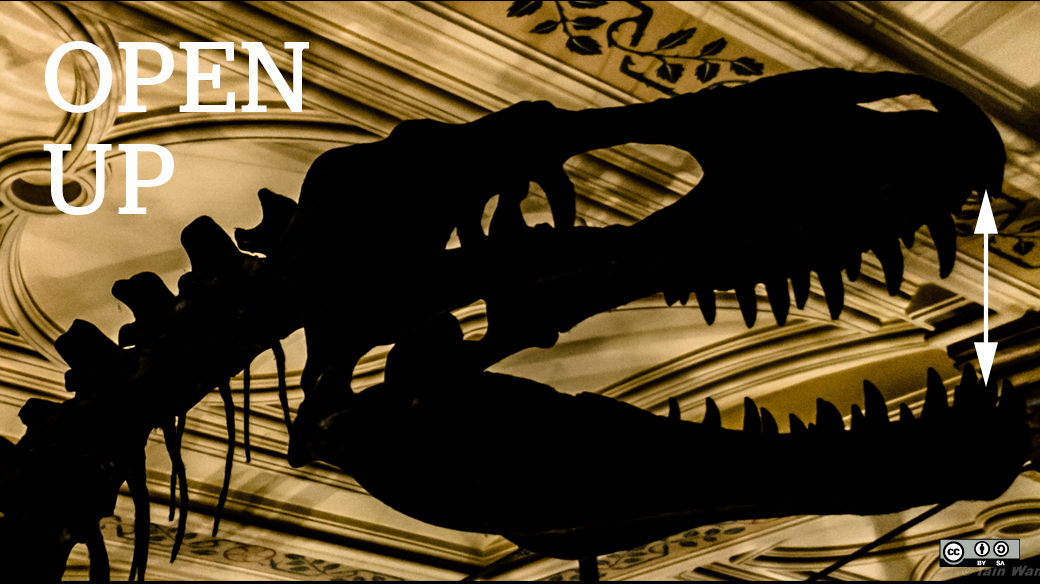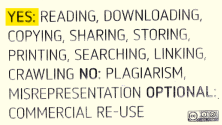As we enter 2015, it’s a good time to reflect on the state of paleontology and the state of open access. Because I’m a dinosaur paleontologist (my apologies to the other 99% of life that ever lived), this post will of course address that clade in particular!
Thirty-eight new genera or species of dinosaur were announced in 2014 (according to my count based on a list at Wikipedia and the dinosaur genera list), spanning everything from sauropods to tyrannosaurs to horned dinosaurs. Seventeen of these were published in open access or free-to-read journals. This works out to around 45%.
PLOS ONE continues to dominate the world of open access dinosaur species—nine of those 17 were published there. I will be very interested to see if this trend continues into future years, particularly as more open access journals enter publication. Seven other journals hosted open access or free-to-read papers on new taxa. These included publications hosted by professional societies, “big publishers,” museums, and the like.
You’ve probably noted by now that I’ve been parsing a difference between “open access” and “free to read.” The former category includes those that are fully BOIA-compliant; usually this means publication under a Creative Commons Attribution (CC-BY) license. This freely allows redistribution, repurposing, translation, and other uses, as long as the author is credited (interestingly, I note that many critics of CC-BY conveniently forget that authors must always be attributed). Eleven out of 17 species were published under a CC-BY license. The remainder were under a variety of licenses (e.g., CC-BY-NC-SA). I will confess a certain amusement at the “NC” (non-commercial) clause, particularly when used by very much for-profit and very much commercial publishers (to their credit, a strict CC-BY license is now the default offering for NPG’s Scientific Reports).
Overall, 2014 (17/36 new taxa are free-to-read) doesn’t reflect a big change from 2013 (16/38 free to read). I would be interested to see what percentage of the overall paleontology literature (not just alpha taxonomy) is freely available. Anyone up to collating this?
Full disclosure: I was an author on one of the papers naming a new dinosaur this year, and was handling editor for some of the other papers naming new dinosaurs.
| Taxon | Freely readable | CC-BY? | Journal |
| Adelolophus | No | No | |
| Arcovenator | No | No | |
| Augustynolophus | No | No | |
| Changyuraptor | No | No | |
| Daurosaurus | No | No | |
| Eousdryosaurus | No | No | |
| Gobivenator | No | No | |
| Gongpoquansaurus | No | No | |
| Kulindadromeus | No | No | |
| Kulindapteryx | No | No | |
| Laquintasaura | No | No | |
| Mercuriceratops | No | No | |
| Panguraptor | No | No | |
| Pentaceratops aquilonius | No | No | |
| Plesiohadros | No | No | |
| Qianzhousaurus | No | No | |
| Quetecsaurus | No | No | |
| Rhinorex | No | No | |
| Vahiny | No | No | |
| Zaraapelta | No | No | |
| Zby | No | No | |
| Allosaurus lucasi | Yes | No | Volumina Jurassica |
| Datanglong | Yes | No | Acta Geological Sinica |
| Dreadnoughtus | Yes | No | Scientific Reports |
| Fosterovenator | Yes | No | Volumina Jurassica |
| Rukwatitan | Yes | No | Journal of Vertebrate Paleontology |
| Huangshanlong | Yes | No? | Vertebrate PalAsiatica |
| Anzu | Yes | Yes | PLOS ONE |
| Aquilops | Yes | Yes | PLOS ONE |
| Chuanqilong | Yes | Yes | PLOS ONE |
| Leinkupal | Yes | Yes | PLOS ONE |
| Nanuqsaurus | Yes | Yes | PLOS ONE |
| Tachiraptor | Yes | Yes | Royal Society Open Access |
| Tambatitanis | Yes | Yes | Zootaxa |
| Torvosaurus gurneyi | Yes | Yes | PLOS ONE |
| Yongjinglong | Yes | Yes | PLOS ONE |
| Zhanghenglong | Yes | Yes | PLOS ONE |
| Ziapelta | Yes | Yes | PLOS ONE |
Want more open dinosaur news? Check out this write-up about Smithsonian National Museum of Natural History employees who are scanning and 3D printing T. Rex bones.
Originally on The Integrative Paleontologists blog. Reposted via Creative Commons.







Comments are closed.